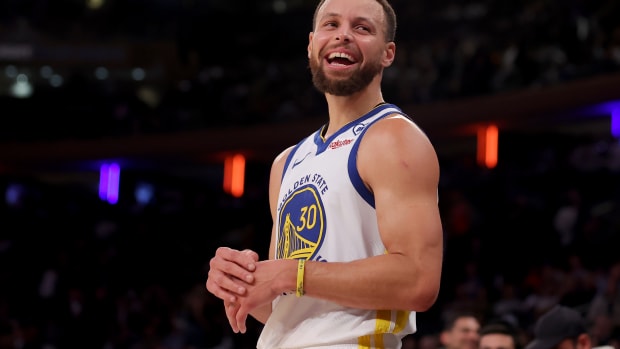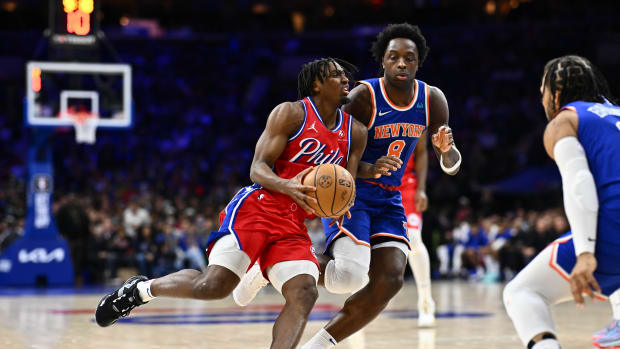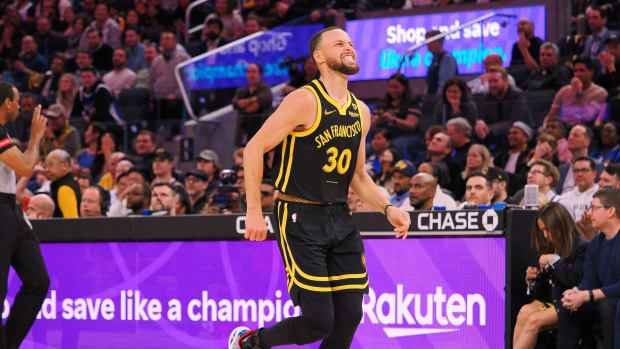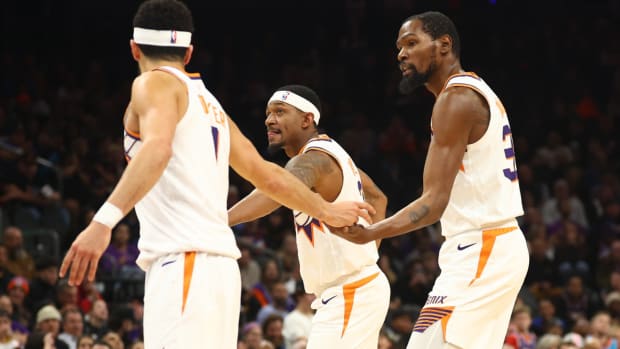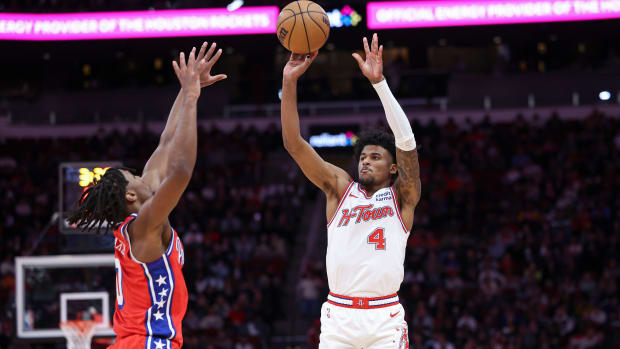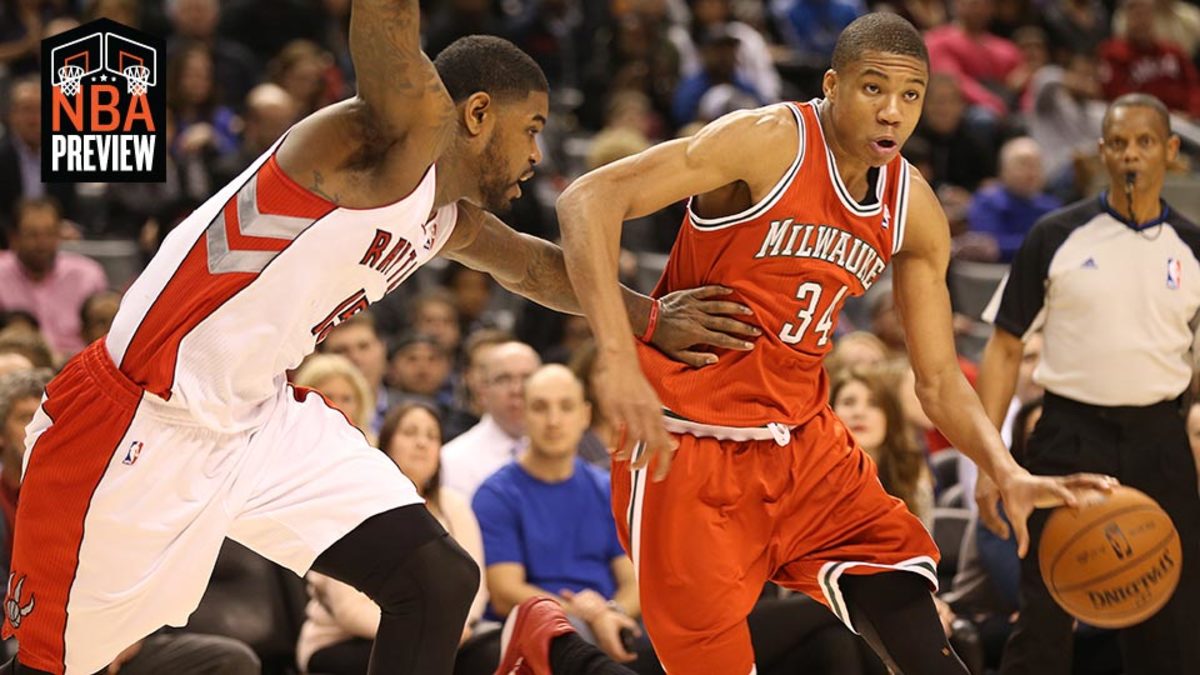
Growing up: Five sophomores set to take the next step in 2014-15
Slim pickings. That’s the only way to describe the collective rookie performance of the 2013 draft class.
A quick rundown finds the class enveloped in a forgettable fog from top to bottom. No. 1 pick Anthony Bennett endured a catastrophic season filled with questions about his conditioning and health. The top three Rookie of the Year candidates – eventual winner Michael Carter-Williams, Victor Oladipo and Trey Burke -- played for cellar-dwellers that won an average of 22 games. Four of the top-10 picks – Otto Porter, Alex Len, Nerlens Noel and CJ McCollum – missed significant time due to injury. And only one of the class’s under-21 players – Giannis Antetokounmpo – showed hints of superstar potential.
There was bound to be a dip in production following a 2012 class that included Anthony Davis, Damian Lillard and Andre Drummond, but this amounted to a cliff dive. Need more evidence of the 2013 class’s weak first impression? All told, rookies – including undrafted players -- played a total of 44,622 minutes in 2013-14, down 20 percent from the previous season. Of the 222 total NBA players who produced at least 2 Win Shares in 2013-14, only seven were rookies. By comparison, 16 rookies managed to accomplish that feat in 2012-13.
Come playoff time, the rookies mostly exited stage left. Eighteen rookies appeared in the playoffs, logging a total of 864 playoff minutes; as a point of comparison, Kevin Durant logged 815 minutes by himself, and his Thunder didn’t even advance to the Finals. Just five rookies logged 50+ postseason minutes, and Oklahoma City center Steven Adams was the only member of the 2013 class to play meaningful minutes for one of the four conference finalists.
There’s nowhere to go but up for the 2013 class. Here’s a look at five notable rising sophomores looking to take the next step in 2014-15.
Trey Burke, Jazz
Burke faces rosier prospects this season than either Carter-Williams or Oladipo. Unlike his colleagues in Philadelphia and Orlando, Burke is surrounded by a roster that, while very young, is logically constructed and better than its 25-win campaign in 2013-14 indicated. Remember, it was Burke’s early-season injury absence that was the major factor in the Jazz’s 1-15 start.
Evaluating over/under win totals for the 2014-15 NBA season
Burke’s rookie season (12.8 points, 5.7 assists, 3 rebounds) was fairly typical for a young point guard tossed into the fire: his shooting numbers (38 percent overall and 33 percent from deep) were far from ideal, he needed more offensive help than was available to him and he struggled mightily to defend his position. His 6-foot height presents obstacles on both ends – he finished just 44.7 percent of his shots in the basket area and is an easy target for bigger guards to pick on – but his confidence level and comfort factor are bound to improve. New coach Quin Snyder seems to have a firm grasp on his point guard’s strengths and weaknesses, as he’s angling to increase the pace, find early offense and tighten up the the pick-and-roll defense.
With fellow first-round picks Derrick Favors, Gordon Hayward, Alec Burks, Enes Kanter and Rudy Gobert all returning and poised for age-related improvement, year two for Burke represents the possibility of real team-wide progress, something that is almost certainly out of reach for either Carter-Williams and Oladipo. That’s true even though Utah used its 2014 lottery pick on Australian point guard Dante Exum, 19, who will eventually push Burke for the right to be the Jazz’s lead ball-handler. Burke’s task is to oversee that rise by making marginal improvements as a shooter, finisher and decision-maker while taking real strides as a defender. A lack of pressure to make the postseason should help his cause.
Victor Oladipo, Magic
There will likely be times this season when Oladipo feels like a rookie all over again. Yes, Oladipo played a class-high 2,487 minutes in 2013-14, but many of the faces around him have changed. Most critically, the Magic will lose ArronAfflalo and Jameer Nelson, the only two other players to log at least 2,000 minutes last year. Oladipo generally shared the court with one or both of them; their replacements (Ben Gordon, Evan Fournier, Elfrid Payton) are clear downgrades in the short-term. Oladipo must also adapt to the arrivals of lottery pick Aaron Gordon and veteran forward/center Channing Frye, two players who figure into the Magic’s longer-term plans.
What Oladipo, 22, should expect to gain this season is greater positional clarity. The 6-foot-5 guard should expect to start on a full-time basis – something that wasn’t guaranteed last season – while logging plenty of minutes alongside Payton, a 2014 lottery pick who is a natural point guard. This is a partnership that will require patience, but alleviating Oladipo of offense-initiation duties while also keeping him near the top of the offensive pecking order is the right play. Finding a player in Payton who seems to take similar pride in playing both ways also makes sense, even if the duo will face questions about whether their overall games are more redundant than complementary.
A knee injury could delay Oladipo’s 2014-15 debut, but that’s hardly a huge concern for a talent-deficient Magic roster poised for another 20-something win season. The only thing that truly matters in 2014-15 is whether the Oladipo/Payton combination looks to be a keeper.
Giannis Antetokounmpo, Bucks
The legend surrounding Antetokounmpo – the rags-to-riches personal story, the “Greek Freak” persona, the never-ending growth spurts, the occasional Durant-esque stretch dunks – has fully lapped his play as a rookie. Acknowledging that fact is a necessary reality check amid all the hype and promise.
SI.com's Top 100 NBA players of 2015
Antetokounmpo produced like a teenaged project (6.8 points, 4.4 rebounds, 1.9 assists) last season while playing a major role on a Bucks team that finished with the league’s worst record. He’s certainly not to blame for all that losing – on the contrary, he was easily the brightest ray of hope during a horrendous season – but it must be acknowledged that the flashes of greatness were not a truly regular occurrence. Antetokounmpo’s career high is a modest 16 points, he struggled to score consistently from anywhere inside the arc, and he was nearly as likely to commit a turnover as register an assist.
Anything approaching criticism of Antetokounmpo at this point is totally unwarranted. At 19, he is nearly two full years younger than Anthony Davis, the NBA’s prodigy du jour, and he’s still at the stage where his comfort moving with and without the basketball is improving rapidly and not yet settled. Antetokounmpo played well both at the Las Vegas Summer League, where he and Andrew Wiggins often appeared to be the two players with the biggest upside, and the FIBA World Cup.
The nice thing about Antetokounmpo’s decision to come to the NBA immediately is that he isn’t yet burdened by specific expectations and demands like some of his older classmates. Being ahead of the curve allows for a freedom to experiment with different positions and juggle various responsibilities, while also providing plenty of time to fit a fit with 2014 lottery pick Jabari Parker. More minutes, more touches and more shots will lead to improved numbers, but development -- however and wherever it comes over the next two seasons -- is sufficient. Antetokounmpo is the closest thing the NBA has to a blank canvas.
Cody Zeller, Hornets
What’s best for a team isn’t always best for each of its individual members. Zeller, 22, finds himself in the middle of such a divergence: the loss of Josh McRoberts was an unmistakable blow to Charlotte’s outlook, but it sets the table nicely for Zeller’s prospects, both immediately and into the future.
As a rookie, the 7-foot Zeller (6 points, 4.3 rebounds, 1.1 assist in 17.3 minutes) was a fringe rotation player, often looking timid or out of step with the gameflow. Coach Steve Clifford leaned on McRoberts for a career-high 30.3 minute per game, a role he seems unlikely to completely hand over to free-agent signing Marvin Williams. More of a combo forward rather than a true four, Williams isn’t going to replace McRoberts’ vision and craftiness, and he hasn’t logged 30 minutes a night since 2009-10.
A fluid big man who is comfortable facing the basket, Zeller must learn (relearn, really) to trust his scoring ability. Spacing off of Al Jefferson will require the ability to confidently take and regularly make mid-range shots, two things Zeller struggled mightily with as a rookie. Recent reports suggest that Zeller might be utilized as both a back-up four and five, but he would do well to start thinking of himself solely as Charlotte’s starting power forward of the future. If he isn’t holding down that position one year from now, something will have gone wrong.
Steven Adams, Thunder
Sometimes Adams, a 21-year-old 7-footer, seems almost too good to be true. Oklahoma City’s fans haven’t had much to complain about during the Kevin Durant Era, but the hapless play of Kendrick Perkins is at the very top of that list. The plodding Perkins has generated so many fouls and turnovers for so many years that it stopped being a laughing matter years ago, and the only two-word phrase uttered as often as “Boomer Sooner” in the state of Oklahoma is “Amnesty Perk.” Somehow, in spite of all the warranted criticism, Perkins returns this season to play out the final year of his contract.
Ten questions with Bob Ryan: Celtics tales, NBA's G.O.A.T. and 'Scribe'
Irritated Thunder fans can rejoice that GM Sam Presti has found a transition plan in Adams, a Kiwi center who beat most prognostications by serving as a worthwhile rotation player (3.3 points and 4.1 rebounds in 14.8 minutes) as a rookie. A master instigator, Adams is tasked with using his length and athleticism to protect the paint, clear the glass and finish high-percentage opportunities. Generally speaking, he’s proven up to those challenges, albeit in a contained environment. As he develops, Adams will need to find a way to tone down his over-eagerness without throttling his high energy level; that way, he can better avoid both foul trouble and positioning issues.
But save the nitpicking for later. The 2014-15 season is a honeymoon period for Adams, who plays a physical, fan-friendly style and scores points for not taking himself too seriously. Perkins’ face seems fixed into a permanent scowl; Adams isn’t afraid to smile or smirk, and he even grew a bushy moustache solely for the purpose of enhancing his Media Guide photo. A reasonable goal for Adams in 2014-15 would be ramping up his playing time to 20-25 minutes a night, setting the stage for the crazy-long frontline of Durant, Serge Ibaka and Adams that should totally come to fruition in the post-Perkins era. If he manages to lock down the starting job between now and the 2015 playoffs, all the better.






























